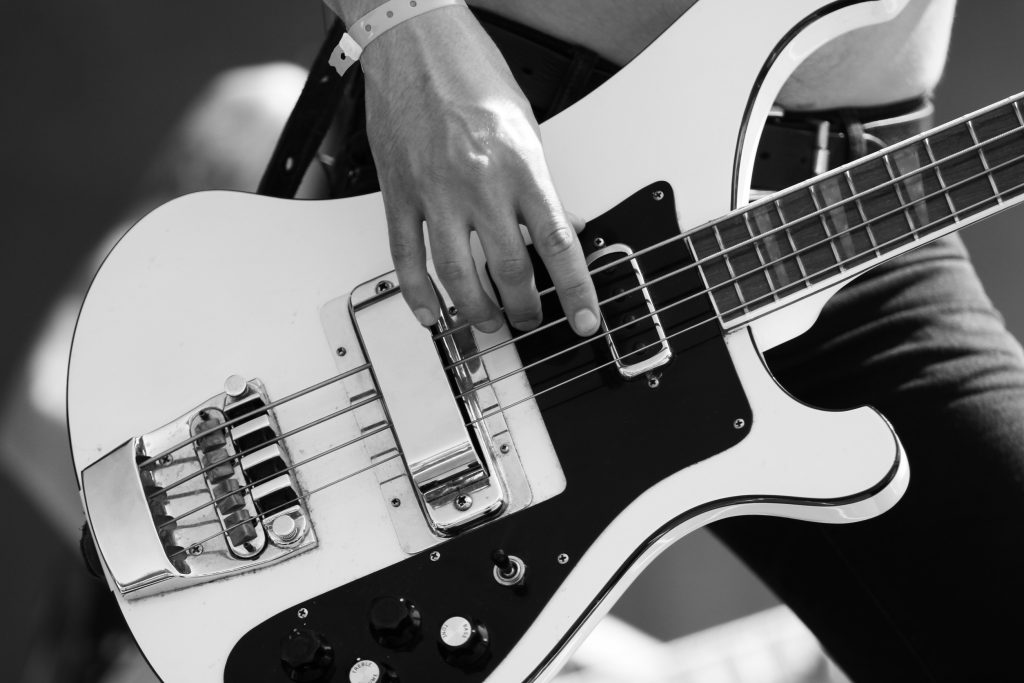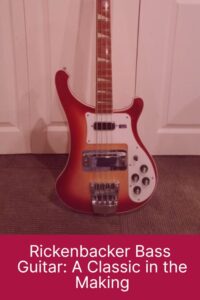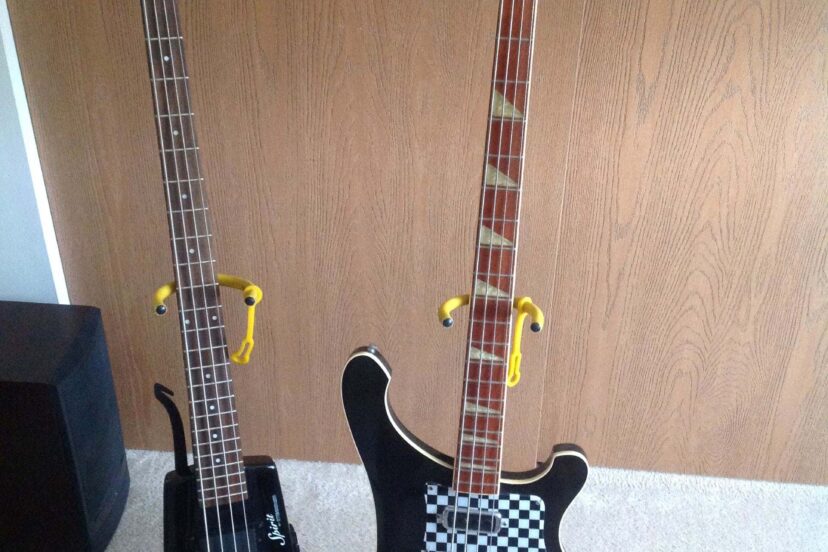Rickenbacker Bass Guitar: A Classic in the Making
Introduction: The Iconic Rickenbacker Bass Guitar
At the time of this writing, my Rick 4001 is 44yrs. old. So, I’m thrilled to discuss one of the most iconic brands in the bass world – Rickenbacker. Known for its distinctive tone and impressive craftsmanship, a Rickenbacker Bass Guitar is truly a gem.
The Legacy of Rickenbacker
The Rickenbacker story began in the early 1930s, evolving over decades to become a favorite of many legendary musicians. Their bass guitars are recognized for their unique “ringing” sound, making them a staple in classic rock.
Understanding Rickenbacker Bass Guitar Models
Over the years, Rickenbacker has released numerous models. Each model carries its unique character, but here are a few fan favorites:
Rickenbacker 4001:
Introduced in the 1960s, the 4001 model is a true classic. Known for its melodic and punchy tone, it’s no surprise that it was the choice of The Beatles’ Paul McCartney. It is an iconic and legendary bass guitar that has left an indelible mark on the world of music. Known for its distinctive design, unique tonal characteristics, and rich history, the Rickenbacker 4001 has been a favorite of bassists across various genres since its introduction in the early 1960s.
Key features of the Rickenbacker 4001 model bass guitar include:
- Body and Neck: The 4001 typically features a sleek, double-cutaway body design made from high-quality maple, which contributes to its iconic look. The neck is made of maple as well, known for its stability and bright tone. The set neck construction provides excellent sustain and resonance.
- Scale Length: It features a 33.25-inch scale length, slightly longer than many other bass guitars, which contributes to its unique tone and feel.
- Fingerboard: The fingerboard is typically made from rosewood or maple, offering a smooth playing surface with comfortable frets for ease of navigation and comfortable playability.
- Pickups: The Rickenbacker 4001 is most famous for its distinctive pickups. It comes equipped with a pair of high-gain single-coil pickups, known as “toaster” pickups. These pickups are responsible for the guitar’s unique, bright, and clear sound, characterized by a pronounced midrange and tight lows.
- Electronics: The 4001 features a straightforward control layout with individual volume and tone controls for each pickup, allowing for a wide range of tonal shaping. The unique “Rhythm/Solo” switch offers further tonal versatility, allowing players to switch between two preset tonal profiles.
- Hardware: Rickenbacker basses are known for their high-quality hardware. The 4001 typically features a bridge with adjustable saddles for precise intonation and a distinctive triangular-shaped tailpiece that adds to its visual appeal.
- Aesthetic: One of the standout features of the Rickenbacker 4001 is its instantly recognizable design. The body shape, distinctive headstock, and checkerboard binding on the body and neck give it a classic and timeless appearance.
- Iconic Sound: The Rickenbacker 4001 is beloved for its unique tonal characteristics. Its bright and punchy sound, often described as “jangle,” is perfect for cutting through a mix in rock, progressive, and punk genres. It has been notably used by legendary bassists like Paul McCartney of The Beatles, Chris Squire of Yes, and Geddy Lee of Rush.
Overall, the Rickenbacker 4001 is a legendary bass guitar with a timeless design and a distinctive sound that has left an indelible mark on the world of music. Whether on stage or in the studio, this bass continues to be a cherished choice for many bass players seeking its signature tone and iconic style.

Rickenbacker 4003:
The Rickenbacker 4003 is a legendary bass guitar renowned for its iconic design, rich history, and unique tonal characteristics. As a successor to the earlier Rickenbacker 4001 model, the 4003 has been a staple in the world of music since its introduction, and it continues to be a favorite choice among bassists across various genres.
Here’s a detailed description of the Rickenbacker 4003 model bass guitar:
- Body and Neck: The Rickenbacker 4003 features a distinctive double-cutaway body design, typically crafted from high-quality maple wood. The neck is also made of maple, offering stability and a bright tonal character. Its set neck construction contributes to sustain and resonance.
- Scale Length: The 4003 boasts a 33.25-inch scale length, slightly longer than many other bass guitars. This extended scale length adds to its unique feel and contributes to its distinctive tonal characteristics.
- Fingerboard: The fingerboard of the 4003 is typically made from rosewood or maple, providing a smooth playing surface with comfortable frets for ease of navigation and comfortable playability.
- Pickups: The 4003 comes equipped with a pair of high-gain single-coil pickups, known for their clear and punchy sound. These pickups, often referred to as “Hi-Gains,” deliver a unique tonal signature with pronounced mids, tight lows, and a clear, articulate high end.
- Electronics: The control layout of the Rickenbacker 4003 is straightforward, featuring individual volume and tone controls for each pickup. This setup allows for precise tonal shaping and versatility in achieving various sounds. Additionally, the “Rhythm/Solo” switch provides preset tonal options to further expand the tonal palette.
- Hardware: Rickenbacker basses are known for their high-quality hardware. The 4003 typically features a bridge with adjustable saddles for precise intonation and a distinctive “R”-shaped tailpiece, adding to its visual appeal.
- Aesthetic: The Rickenbacker 4003 is instantly recognizable due to its classic and timeless design. The unique body shape, iconic “cresting wave” headstock, and checkerboard binding on the body and neck give it a distinctive and memorable appearance.
- Iconic Sound: The 4003’s tonal character is often described as punchy, clear, and articulate. It is particularly well-suited for rock, progressive, and alternative genres, and it has been the choice of numerous influential bassists throughout history, including Geddy Lee of Rush, Chris Squire of Yes, and Lemmy Kilmister of Motörhead.
In summary, the Rickenbacker 4003 is an iconic bass guitar known for its unique design, distinctive tonal characteristics, and rich musical history. Whether you’re on stage or in the studio, this bass continues to be a beloved choice for musicians seeking its legendary tone and iconic style.
Rickenbacker 4004:
The Rickenbacker 4004 model bass guitar is a high-quality instrument known for its craftsmanship, distinctive design, and exceptional sound. Manufactured by Rickenbacker, a company with a long history of producing innovative electric guitars and basses, the 4004 series continues the tradition of excellence. Here are some key features and aspects of the Rickenbacker 4004 model:
- Construction and Design: The Rickenbacker 4004 basses are crafted with a solid body, often made from high-grade maple or walnut, providing a sturdy foundation that contributes to its sustain and resonance. The design features sleek, curved lines and a distinctive body shape that is both ergonomic and visually striking. The neck is typically constructed from maple and fitted with a rosewood or maple fingerboard, featuring dot or triangle inlays for a classic aesthetic.
- Electronics and Sound: Equipped with one or two high-output humbucking pickups, the 4004 models deliver a clear, punchy tone with plenty of depth. The electronics also include a volume and tone control for each pickup, allowing players to sculpt their sound with precision. The bass is renowned for its versatility, capable of producing everything from warm, smooth lows to aggressive, cutting highs, making it suitable for a wide range of musical genres.
- Hardware: The hardware on the Rickenbacker 4004 series is designed for reliability and performance. This includes a high-quality bridge that provides excellent intonation and adjustable string height, ensuring that the bass plays smoothly across all frets. The tuning machines are robust and precise, keeping the bass in tune even during extended playing sessions.
- Finish and Aesthetics: Rickenbacker basses are known for their beautiful finishes, and the 4004 models are no exception. Available in a variety of colors and finishes, including the iconic Fireglo, Jetglo, and Mapleglo, these instruments are as visually appealing as they are musically. The glossy finish not only enhances the bass’s appearance but also protects the wood, ensuring the instrument’s longevity.
- Playability: With a comfortable neck profile and accessible fretboard, the 4004 models are designed for ease of playability. Whether playing fingerstyle, with a pick, or slapping, the bass feels balanced and responsive. The action can be easily adjusted to suit the player’s preference, making it a favorite among professional bassists for both live performances and studio recordings.
In summary, the Rickenbacker 4004 model bass guitar embodies the qualities that have made Rickenbacker a revered name in the music industry. With its superior construction, versatile sound, and stunning aesthetics, the 4004 series stands out as a premium choice for bassists seeking an instrument that performs exceptionally in every aspect.
Features of Rickenbacker Bass Guitars
What makes a Rickenbacker truly special? Let’s delve into some of their key features:
The Craftsmanship:
Rickenbacker bass guitars are known for their superb craftsmanship. The attention to detail and use of high-quality materials make them truly stand out.
The Neck and Fretboard:
Most Rickenbacker bass guitars feature a neck-through-body construction for enhanced sustain. The comfortable neck profile and high-quality fretwork make for a great playing experience.
The Electronics:
Rickenbacker’s high-gain pickups produce a distinctive tone that’s bright, punchy, and full of character.
Caring for Your Rickenbacker Bass Guitar
Like any premium instrument, a Rickenbacker requires care to maintain its performance and aesthetics:
Cleaning and Maintenance:
Regular cleaning and string changes are essential. Also, make sure to adjust the truss rod and bridge when necessary for optimal playability.
Storing Your Rickenbacker:
Proper storage of a Rickenbacker bass guitar, or any high-quality musical instrument, is crucial for maintaining its condition, playability, and sound quality over time. Here are detailed guidelines for storing your Rickenbacker bass to ensure it remains in top condition:
1. Climate Control
- Temperature: Store the bass in a room where the temperature is consistently between 65-75°F (18-24°C). Extreme temperatures can cause the wood to expand or contract, leading to potential damage.
- Humidity: Maintain a relative humidity (RH) level of 45-55%. Use a humidifier in dry environments or a dehumidifier in damp conditions. Excessive dryness can cause the wood to crack, while too much moisture can lead to warping and swelling.
2. Cleaning Before Storage
- Body and Neck: Clean the body and neck with a soft, dry cloth to remove fingerprints, dust, and sweat. For tougher grime, use a slightly damp cloth followed by a dry one.
- Strings: Wipe down the strings with a suitable string cleaner to prolong their life and maintain tone quality.
- Fretboard: Occasionally clean the fretboard with a fretboard-specific cleaner and conditioner to keep the wood healthy and prevent drying or cracking.
3. Loosening Strings
- If storing for a long period, consider loosening the strings slightly to reduce tension on the neck. However, do not completely detune the instrument, as maintaining some tension is necessary to keep the neck straight.
4. Use a Case
- Hardshell Case: Store the bass in a hardshell case to protect it from dust, humidity changes, and physical damage. Ensure the case is clean and dry before placing the instrument inside.
- Support: Use neck supports and body cushions available in the case to prevent movement and ensure the bass is snugly fitted, reducing the risk of damage to the finish and components.
5. Positioning the Case
- Orientation: Store the case horizontally rather than standing up to reduce pressure on the sides and prevent the bass from resting on its neck.
- Avoid Ground Contact: If possible, keep the case off direct contact with the floor, especially in basements or areas prone to dampness, to protect against moisture and temperature fluctuations.
6. Avoid Direct Sunlight and Heat Sources
- Store the bass away from direct sunlight, radiators, air conditioning units, and other sources of heat or cold air drafts, as these can lead to finish cracking and wood warping.
7. Regular Check-ups
- Periodically check the instrument, even if it’s not being used regularly. Look for signs of damage, play it for a bit to ensure everything is in working order, and adjust storage conditions as necessary.
By following these guidelines, you can help ensure that your Rickenbacker bass remains in excellent condition, preserving its playability, sound, and value for many years to come.
Conclusion: Why Choose a Rickenbacker?
As we’ve journeyed through the history, features, and care of a Rickenbacker bass guitar, it’s clear why these basses are so revered. With their unmistakable tone, exceptional craftsmanship, and rich legacy, a Rickenbacker bass guitar is truly an investment in your musical journey.

FAQ’s
- What’s unique about the Rickenbacker bass guitar sound?
The Rickenbacker sound is often described as bright, punchy, and full-bodied with a characteristic ‘ringing’ quality. - Are Rickenbacker bass guitars good for beginners?
While a Rickenbacker is a excellent instrument, they might be an investment for beginners due to their premium pricing. However, if budget allows, they can certainly be a great start. - How often should I maintain my Rickenbacker bass guitar?
Regular cleaning after every use and string changes every 3-6 months is recommended, depending on how often you play. Regular servicing is also beneficial. - Why does my Rickenbacker bass guitar sound different from other bass guitars?
The unique construction, materials used, and the high-gain pickups in Rickenbacker bass guitars contribute to their distinctive sound. - What genres are Rickenbacker bass guitars best suited for?
Rickenbacker bass guitars are versatile, but they’re often associated with rock due to their punchy and bright tone.




